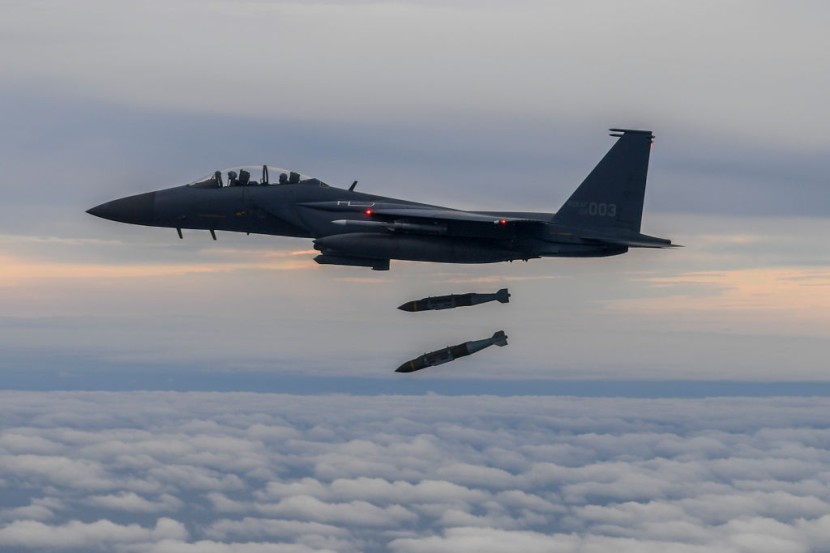
North Korea conducted a test launch of two ballistic missiles capable of impacting Japan, possibly in retaliation for Japan's adoption of a new security strategy that emphasizes an offensive posture against North Korea and China.
The launches occurred two days after North Korea claimed to have conducted a crucial test required for the development of a more mobile, powerful intercontinental ballistic missile meant to hit the US mainland.
US Reiterates 'Ironclad' Support For South Korea, Japan
According to the South Korean and Japanese governments, the two missiles went approximately 500 kilometers (310 miles) at a maximum height of 550 kilometers (340 miles) before landing in the seas between the Korean Peninsula and Japan. The military of South Korea identified both missiles as medium-range weapons launched at an acute angle, implying that they may have flown further if launched on a conventional trajectory.
North Korea tests medium- and long-range missiles at a high angle to avoid neighboring nations. However, in October, it fired an intermediate-range missile over Japan, prompting Tokyo to issue evacuation notices and halt trains. In an emergency conference, top South Korean security officials condemned North Korea's continuous provocations, which they claimed occurred despite "the agony of its inhabitants wailing in hunger and cold because of a severe food shortage."
South Korea will increase trilateral security cooperation with the United States and Japan, according to the presidential office of South Korea. Separately, Japanese Vice Defense Minister Toshiro Ino condemned North Korea for endangering Japan, the region, and the international community.
The US Indo-Pacific Command stated that the launches illustrate the destabilizing consequences of North Korea's illegal ballistic missile and weapons of mass destruction programs. Per AP News, it noted that the US defense commitment to South Korea and Japan "remains ironclad."
#USINDOPACOM Statement on #DPRK Missile Launch: "We are aware of the ballistic missile launches and are consulting closely with our allies and partners."
— U.S. Indo-Pacific Command (@INDOPACOM) December 18, 2022
Read more ⬇️https://t.co/BWN25S7vlz
South Korean military stated that the missiles were launched at intentionally steep angles so that they would go lesser distances than intended. The missiles are categorized by South Korea as medium-range ballistic missiles that typically travel between 620 to 1,860 miles.
When launched from North Korea, these missiles might reach most or all of Japan. The United States maintains a military presence in Japan, which might be drawn into any future battle on the Korean Peninsula. North Korea displayed its ability to launch ballistic missiles toward Japan by launching missiles over the country in 2017 and again in October.
Japan protested North Korea's launch on Sunday through its embassy in Beijing, senior vice defense minister Toshiro Ino told reporters, as reported by the Kyodo news agency. Two days before the North's missile launches, Japan revised its national security plan for the first time in nine years, citing increased threats from China, North Korea, and Russia and pledging to double its military expenditure budget.
Japan's revised buildup plans included the acquisition of counterstrike capabilities, including missiles that might be deployed to target enemy bases in the event of an assault, NY Times reported.
Japan aims to buy around one thousand missiles, beginning with Tomahawks manufactured in the United States before transitioning to its military systems. In its latest national security documents, North Korea's recent military activities are described as "imminently threatening."
Read Also : Russia-Ukraine War: USA Set To Send Patriot Missile Defense System That Could Help Ukraine in Massive Way
North Korea Missiles
North Korea has fired at least 90 ballistic and other missiles this year, more than in any previous year, despite United Nations Security Council resolutions prohibiting the development and testing of ballistic missile and nuclear weapons technology.
In addition, there have been fears that North Korea may execute its first nuclear test in five years. The US and South Korean officials told CBS News at the end of October that Pyongyang is prepared to conduct its first nuclear test since 2017 in the near future.
The precise condition of North Korea's nuclear assault capabilities remains secret since all of its intercontinental ballistic missile tests in recent years were conducted at a steep angle to avoid surrounding nations.
Given the time invested in its nuclear program, some experts believe North Korea now possesses nuclear-tipped missiles capable of striking the United States. Others assert that North Korea is still years away from getting such weapons, arguing that it has yet to demonstrate publicly that it possesses the technology to shield warheads from the severe conditions of atmospheric reentry.
@YouTube© 2025 HNGN, All rights reserved. Do not reproduce without permission.








